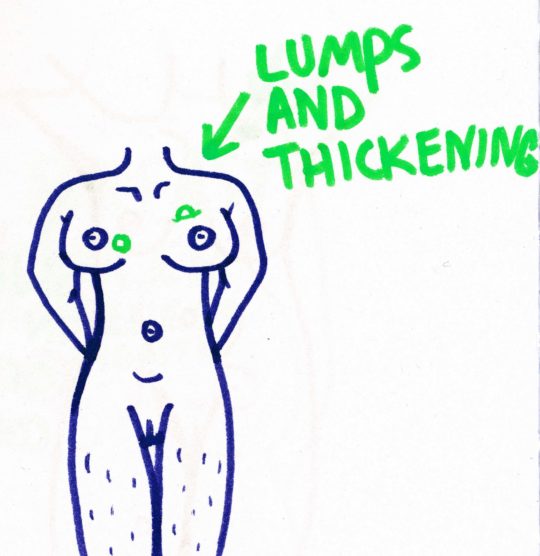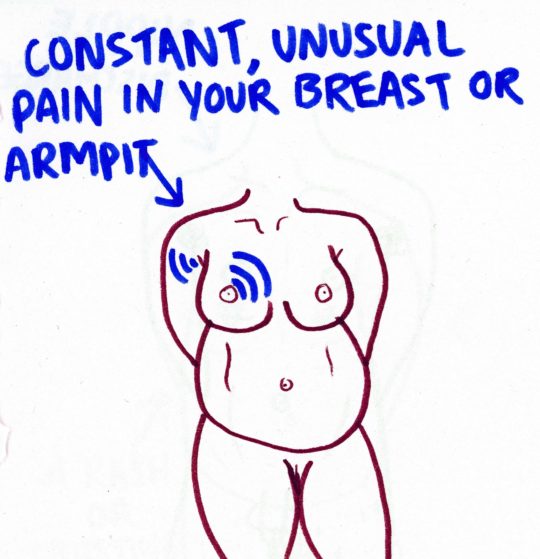
It’s Breast Cancer Awareness Month: Here’s how and why Lancs students should check their breasts
Everyone should know how to check for breast cancer, here’s a step-by-step guide
As you may or may not know, the month of October shines a bright and important light on Breast Cancer Awareness, so let’s talk about it. To stay safe and catch signs early, we need to become masters at understanding what feels normal for our boobs. According to the National Breast Cancer Foundation, we should all be checking our breasts for lumps at least once a month (that means you too boys).
We all acknowledge the seriousness of the disease and the brutality of its nature, a challenge none of us wants to be faced with. Cancer Research UK has shared some shocking statistics regarding the disease, which especially (but not exclusively) affects women. From 2015-2017, there were around 31 deaths per day, making breast cancer the second most deadly after lung cancer. Despite the common misconception that breast cancer only affects women, 350 men are diagnosed each year, with a recorded 80 deaths in 2017.
Preparation is key to catching cancer early, so even Lancaster students should start looking. The Lancaster Tab have provided some visual illustrations to aid you in understanding the signs of what to look out for when checking yourself for lumps and bumps every month.
Keep in mind, that all breasts are different, and what’s normal for one person, may not be normal for another. The NHS also indicates that for many women, the breasts and underarm areas can feel more tender and sensitive during menstruation, so keep this in mind when doing regular checks. On the other hand, don’t be quick to disregard any signs that may be of concern; it’s always best to get checked.
Start by looking in the mirror
According to VICE’s guide in checking your breasts for signs of cancer, you should start by standing in front of your mirror and raising both arms, then look for any changes in the nipple and the breast.

Put your hands on your hips
VICE also suggests whilst standing and looking at a mirror, to put your hands on your hips, and push your shoulders forward- looking for any further changes in the underarm, breast and collarbone region.

Roll the tissue under your fingers
The third suggestion VICE gave when checking for signs of breast cancer was to roll the breast tissue under your fingers, feeling for any abnormalities. You must cover the whole breast and underarm when doing this. Below are some images to remind you of what to look out for when performing a self-examination for breast cancer.

Lumps and Thickening
Breast Cancer Charity, Coppafeel, reminds us that the importance of knowing our breasts are vital. Some breasts are naturally lumpy, but any new lumps or areas of thickness should be addressed immediately.

Rashes or Crusting
Another sign to look for is rashes or crusting of the nipple or surrounding area of the breast.

Unusual Pain in Breast or Armpit
The emphasis here is on unusual. Our boobs are naturally sensitive, but if something doesn’t feel right – get it checked!

Nipple Discharge
Another sign to watch for is nipple discharge which occurs without squeezing the breast.

Swelling
Coppafeel explains the importance of not just checking the breast, but areas which surround it (i.e. underarm and collarbone) as those areas also contain breast tissue.

Nipple Changes
During self-examination, pay important attention to your nipple, as changes in shape or direction (i.e. becoming inverted), could be a sign of breast cancer.

If you notice anything unusual during your self-examination, please notify your doctor immediately. It’s most likely nothing to worry about, but it’s always better to get yourself checked just to make sure. You may still feel like you need a little more advice or help on the matter.
There are numerous organisations, charities and helplines, to support you in finding answers to all your questions. Coppafeel is a charity who specialises in educating people about the importance of checking your breasts regularly, to give people the best chance of surviving breast cancer.
The NHS has further information on how to check your breasts for those that would like to know more (i.e. screenings or support services). If you follow this link here; you can insert your postcode which provides a list of cancer support helplines/services in your local area.
The National Breast Cancer Foundation provides a surplus of information, in addition to free educational guides on an array of topics, from nutrition for cancer patients to early detection of breast cancer.
Cancer Research UK educates and informs people about their efforts in beating the disease, in addition to how you can get involved with the organisation.
The charity Breast Cancer Now has a helpline for those with queries, or those who just want to talk things through. Call them on 0808 800 6000.
Macmillan also has dense information about breast cancer, and offer help emotionally, physically and financially for those who find themselves needing it.
Breast cancer is by no means an end; but taking the time to check your boobs every month, may one day save your life. Show your support and spread awareness this month, for Breast Cancer Awareness.
Today (23/10/20), for Breast Cancer Awareness month, anyone wearing pink when ordering from Sultan’s will have 10% of their bill donated to the charity ‘Breast Cancer Now’.
https://www.instagram.com/p/CGp7kslHU4M/
Sultan’s have made this gesture following thousands of other people in communities, schools and workplaces wearing pink for the UK’s largest breast cancer charity, Breast Cancer Now.
*All images have been provided by the author.*
Articles recommended by this writer:
How Lancs students can reduce food waste in light of ‘World Food Day’
‘I don’t really see a point in staying here’: How students feel moving into Tier Three
We asked Lancs students to send in their best house decor and boy did they provide









































